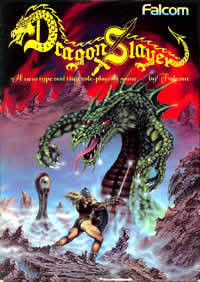Dragon Slayer (video game)
This article needs additional citations for verification. (December 2009) |
| Dragon Slayer | |
|---|---|
 | |
| Developer(s) | Nihon Falcom |
| Publisher(s) | |
| Designer(s) | Yoshio Kiya |
| Series | Dragon Slayer |
| Platform(s) | FM-7, NEC PC-8801, MSX, X1, Super Cassette Vision, Game Boy, Sega Saturn |
| Release | PC-8801
Falcom Classics
|
| Genre(s) | Action role-playing |
| Mode(s) | Single-player |
Dragon Slayer (ドラゴンスレイヤー, Doragon Sureiyā) is an action role-playing game,[2][3] developed by Nihon Falcom and designed by Yoshio Kiya.[4] It was originally released in 1984 for the PC-8801, PC-9801, X1[1] and FM-7,[5] and became a major success in Japan.[6] It was followed by an MSX port published by Square in 1985 (making it one of the first titles to be published by Square),[7] a Super Cassette Vision by Epoch in 1986 and a Game Boy port by the same company in 1990 under the name Dragon Slayer I (ドラゴンスレイヤーI, Doragon Sureiyā Wan). A version for PC-6001mkII was in development but was never released.[8] A remake of Dragon Slayer is included in the Falcom Classics collection for the Sega Saturn.[9]
Dragon Slayer began the Dragon Slayer series, a banner which encompasses a number of popular Falcom titles, such as Dragon Slayer II: Xanadu, Sorcerian, and Legacy of the Wizard. It also includes Dragon Slayer: The Legend of Heroes, which would later spawn over a dozen entries across multiple subseries.
Gameplay
[edit]Dragon Slayer is an early example of the action role-playing game genre, which it laid the foundations for.[2] Building on the prototypical action role-playing elements of Panorama Toh (1983), created by Yoshio Kiya and Nihon Falcom,[10] as well as Namco's The Tower of Druaga (1984),[11] Dragon Slayer is often considered the first true action role-playing game.[2][3] In contrast to earlier turn-based roguelikes, Dragon Slayer was a dungeon crawl role-playing game that was entirely real-time with action-oriented combat,[3] combining arcade style action mechanics with traditional role-playing mechanics.[11]
Dragon Slayer featured an in-game map to help with the dungeon-crawling, required item management due to the inventory being limited to one item at a time,[7] and featured item-based puzzles similar to The Legend of Zelda.[2] Dragon Slayer's overhead action-RPG formula was used in many later games.[6] Along with its competitor, Hydlide, Dragon Slayer laid the foundations for the action RPG genre, including franchises such as Ys and The Legend of Zelda.[7][12]
References
[edit]- ^ a b Falcom Chronicle, Nihon Falcom
- ^ a b c d Kamada Shigeaki, レトロゲーム配信サイトと配信タイトルのピックアップ紹介記事「懐かし (Retro) (Translation), 4Gamer.net
- ^ a b c "Falcom Classics". GameSetWatch. July 12, 2006. Retrieved 2011-05-18.
- ^ John Szczepaniak. "Retro Japanese Computers: Gaming's Final Frontier Retro Japanese Computers". Hardcore Gaming 101. p. 3. Retrieved 2011-03-29. Reprinted from Retro Gamer, 2009
- ^ "Dragon Slayer". Oh!FM7. Retrieved 2015-01-14.
- ^ a b Kurt Kalata, Xanadu, Hardcore Gaming 101
- ^ a b c Kurt Kalata, Dragon Slayer Archived 2011-07-23 at the Wayback Machine, Hardcore Gaming 101
- ^ Szczepaniak, John (21 October 2022). "Poor Pay, Underage Staff And No Credits - Digging Into Falcom's Dark Past". Time Extension. Hookshot Media Ltd. Retrieved 18 December 2022.
- ^ "Falcom Classics". Electronic Gaming Monthly. No. 102. Ziff Davis. January 1998. p. 58.
- ^ Sam Derboo (June 2, 2013), Dark Age of JRPGs (7): Panorama Toh ぱのらま島 - PC-88 (1983), Hardcore Gaming 101
- ^ a b Jeremy Parish (2012). "What Happened to the Action RPG?". 1UP. Archived from the original on 2015-01-12. Retrieved 2015-01-14.
- ^ John Szczepaniak (2016), The Untold History Of Japanese Game Developers, Volume 2, pages 42-49
External links
[edit]- Role-playing video games
- Dragon Slayer (series)
- FM-7 games
- Game Boy games
- MSX games
- NEC PC-8001 games
- NEC PC-8801 games
- NEC PC-9801 games
- Sega Saturn games
- Sharp X1 games
- Action role-playing video games
- 1984 video games
- Video games developed in Japan
- Single-player video games
- Nihon Falcom games
- Square Enix games
- Japan-exclusive video games
